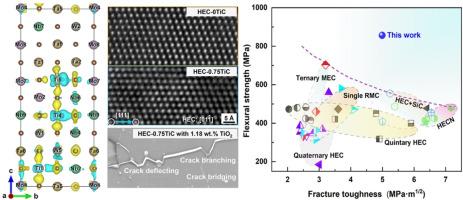Hardness-strength-toughness synergy of (NbMoTaW)C through TiC-TiO2 dual-phase engineering
IF 14.3
1区 材料科学
Q1 MATERIALS SCIENCE, MULTIDISCIPLINARY
引用次数: 0
Abstract
High-entropy carbide ceramics (HECs) face critical limitation in engineering applications due to their inherent brittleness and inadequate flexural strength. Notably, there are pronounced trade-offs between hardness and toughness, and between strength and toughness in HECs. To address these challenges, a dual-phase engineering strategy is proposed in this study to synergistically enhance the mechanical properties of HECs, with (NbMoTaW)C as a representative example. Through the combined effects of TiC solid solution strengthening and in-situ TiO2 toughening, the (NbMoTaW)C demonstrated superior comprehensive mechanical properties, achieving simultaneously high Vickers hardness (20.23±0.26 GPa), high flexural strength (857±23 MPa), and high fracture toughness (4.97±0.16 MPa m1/2), thus resolving the trade-offs between these properties. The formation and adjustment mechanisms of the oxide phase were elucidated. The integrated multiscale characterizations and density functional theory (DFT) calculations illustrated that the lattice distortion induced by the TiC solid solution, along with d-orbital hybridization in the electronic structure, resulted in a significant enhancement in both structural stability and mechanical properties of HEC. Furthermore, the TiO2 particles, strategically formed from oxygen impurities and predominantly located at grain boundaries, significantly enhanced the HEC’s flexural strength. At the same time, the TiO2 particles remarkably improved the toughness of the HEC through crack deflection, bridging, and branching mechanisms. This work has established a synergistic phase optimization strategy that enables overcoming the traditional trade-offs in mechanical properties of HECs.

TiC-TiO2双相工程制备(NbMoTaW)C的硬度-强度-韧性协同效应
高熵碳化物陶瓷由于其固有的脆性和不充分的抗弯强度,在工程应用中面临着严重的限制。值得注意的是,在hec中存在硬度和韧性之间以及强度和韧性之间的明显权衡。为了应对这些挑战,本研究提出了一种双相工程策略,以(NbMoTaW)C为代表,协同提高HECs的力学性能。通过TiC固溶强化和原位TiO2增韧的联合作用,(NbMoTaW)C表现出了优异的综合力学性能,同时实现了高维氏硬度(20.23±0.26 GPa)、高抗弯强度(857±23 MPa)和高断裂韧性(4.97±0.16 MPa /2),从而解决了这些性能之间的权衡。阐明了氧化相的形成和调节机理。综合多尺度表征和密度泛函理论(DFT)计算表明,TiC固溶体引起的晶格畸变以及电子结构中的d轨道杂化导致HEC的结构稳定性和力学性能显著增强。此外,氧杂质形成的TiO2颗粒主要位于晶界处,显著提高了HEC的抗弯强度。同时,TiO2颗粒通过裂纹偏转、桥接和分支机制显著提高了HEC的韧性。这项工作已经建立了一种协同相位优化策略,能够克服传统的hec机械性能权衡。
本文章由计算机程序翻译,如有差异,请以英文原文为准。
求助全文
约1分钟内获得全文
求助全文
来源期刊

Journal of Materials Science & Technology
工程技术-材料科学:综合
CiteScore
20.00
自引率
11.00%
发文量
995
审稿时长
13 days
期刊介绍:
Journal of Materials Science & Technology strives to promote global collaboration in the field of materials science and technology. It primarily publishes original research papers, invited review articles, letters, research notes, and summaries of scientific achievements. The journal covers a wide range of materials science and technology topics, including metallic materials, inorganic nonmetallic materials, and composite materials.
 求助内容:
求助内容: 应助结果提醒方式:
应助结果提醒方式:


